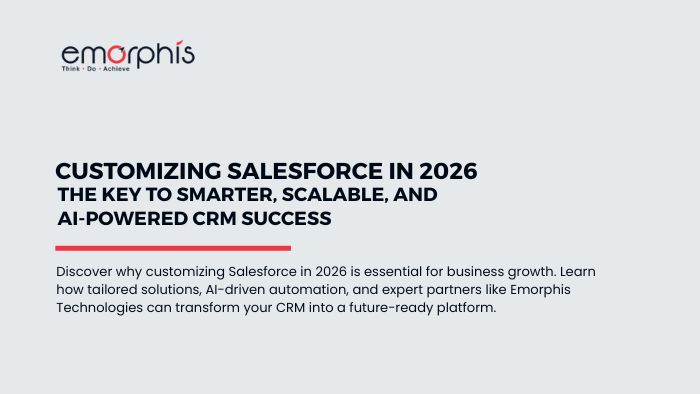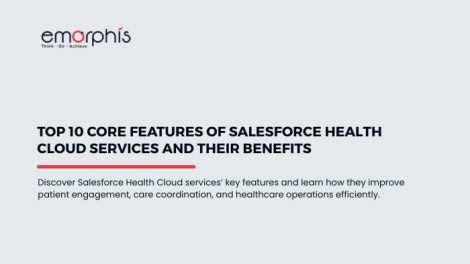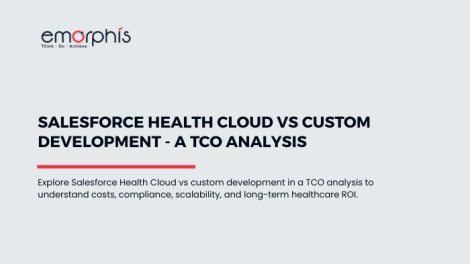What is Trending for Salesforce and Why Customization is Important
In 2026, Salesforce is evolving faster than ever. The platform has become more than just a customer relationship management tool; it’s now a full-scale ecosystem that connects sales, marketing, service, commerce, and analytics under one intelligent layer. This evolution has made customizing Salesforce an essential business strategy rather than a technical choice.
Trending Salesforce Developments in 2026
- AI-Driven Personalization
Salesforce is embedding more predictive intelligence and generative AI features, allowing businesses to automate content creation, lead scoring, and next-step recommendations. This means customizing Salesforce for AI integration will help companies personalize interactions across every touchpoint. - Industry Cloud Expansions
Salesforce continues to release industry-specific clouds for healthcare, finance, retail, and manufacturing. Each industry cloud comes with unique data models and workflows, making customizing Salesforce critical for aligning these frameworks with specific business processes. - Hyper-Automation and Low-Code Development
The rise of Flow Builder and AI-assisted automation means that companies can now configure processes without coding. Still, customizing Salesforce ensures that automation truly reflects the organization’s goals rather than generic templates. - Unified Data Experiences with Data Cloud
With Salesforce Data Cloud, businesses can unify and activate customer data in real time. But to make sense of this vast data pool, customizing Salesforce is necessary to create dashboards, filters, and triggers that provide actionable insights. - Security and Compliance Automation
Global compliance frameworks are becoming more stringent. Salesforce’s new governance tools allow administrators to set security policies automatically, but customizing Salesforce ensures these policies align with local regulations and enterprise data strategies.
Why Customization is More Important Than Ever
In this rapidly transforming environment, no two businesses operate alike. Salesforce’s out-of-the-box setup offers flexibility, but to achieve operational excellence, companies must personalize the system to fit their structure, terminology, and workflows.
Customizing Salesforce helps in:
- Creating user-friendly dashboards that reflect real KPIs.
- Building automated workflows that save time and reduce errors.
- Designing customer journeys that align with company-specific goals.
- Integrating data across systems for a 360-degree business view.
Without customization, companies risk using only a fraction of Salesforce’s potential. In 2026 and beyond, competitive advantage will depend on how intelligently an organization is customizing Salesforce to serve its people and customers.
Points You Should Look at Before You Go for Customizing Salesforce
Before you begin customizing Salesforce, it’s crucial to have a clear strategy. Many businesses rush into configuration changes or new workflows without understanding their long-term impact. Salesforce customization works best when it’s aligned with business objectives, user needs, and system scalability. Here are key points to consider before you start.
1. Define Clear Business Objectives
The first step before customizing Salesforce is identifying why you are doing it. Are you trying to streamline sales operations, improve lead visibility, or enhance customer service response times?
Customization should serve a measurable business goal, such as reducing manual data entry, improving reporting accuracy, or accelerating deal closure rates. Defining these objectives helps guide the entire customization process.
2. Map Existing Processes
Before making any changes, analyze your existing workflows and data structures. Understanding how your teams currently use Salesforce allows you to identify inefficiencies and opportunities for improvement.
When customizing Salesforce, mapping processes ensures that you are enhancing workflows, not duplicating complexity.
3. Choose Between Configuration and Custom Development
Salesforce offers both declarative (no-code) and programmatic (code-based) customization options.
- Configuration involves using tools like Flow Builder, Dynamic Forms, and App Builder to create automations and layouts without writing code.
- Custom Development with Apex, LWC (Lightning Web Components), or Visualforce is ideal when you need advanced logic or unique UI experiences.
Successful customizing of Salesforce projects often balances both approaches, starting with low-code tools and introducing code only where necessary.
4. Focus on Data Quality and Model Design
Your Salesforce data model defines how information flows across your business. Poorly designed models can lead to inconsistent reports and user frustration.
When customizing Salesforce, focus on:
- Creating relevant custom fields and relationships.
- Using picklists and lookups instead of free text for consistency.
-
Eliminating redundant or unused data points.
Clean data ensures reliable analytics and seamless system integration.
5. Prioritize User Experience (UX)
Customization should make Salesforce easier, not harder, for your teams.
Design intuitive page layouts, personalized dashboards, and simplified workflows. The goal of customizing Salesforce is to match the system to the way your teams actually work, reducing clicks and cognitive load.
6. Plan for Integration and Automation
Businesses rarely use Salesforce in isolation. Before customizing Salesforce, evaluate how it will connect with marketing automation tools, ERP systems, communication platforms, or analytics dashboards.
Automations should be planned carefully to avoid overlapping triggers or data loops.
7. Ensure Security, Compliance, and Scalability
Security settings are often overlooked during customization. Review role hierarchies, permission sets, and sharing rules to ensure that sensitive data is properly protected.
When customizing Salesforce, consider how your configuration will scale as the organization grows, with more users, more data, and more automation, all require performance optimization.
8. Create a Maintenance and Testing Plan
Every customization needs testing. Implement sandbox testing for workflows, integrations, and UI changes before pushing them to production.
Establish a maintenance plan for periodic reviews and updates, ensuring your customized Salesforce environment remains healthy and efficient.
Taking these steps before customizing Salesforce ensures a smoother implementation, better user adoption, and long-term success. It also prevents the most common pitfalls, over-engineering, poor data flow, and technical debt.
Customizing Salesforce in 2026
As Salesforce continues to evolve, the landscape in 2026 will demand even deeper personalization and adaptability. Businesses will no longer be satisfied with off-the-shelf CRM experiences. Instead, success will depend on how effectively organizations are customizing Salesforce to match their goals, workflows, and customer expectations.
Here are the key areas where customizing Salesforce will be essential in 2026, along with the specific benefits each customization will deliver:
a. AI-Driven Customer Engagement
Salesforce Einstein and the broader AI Cloud will take center stage in 2026, transforming how businesses interact with customers.
- Customization Needed: Tailoring AI models, predictive lead scoring, and chatbots to align with business-specific data and goals.
- Benefits: Personalized recommendations, automated insights, and smarter sales forecasting, all made possible through customizing Salesforce to your organization’s unique patterns.
b. Industry-Specific Process Automation
Every sector, healthcare, finance, manufacturing, or retail, requires workflows that reflect its operational nuances.
- Customization Needed: Building industry-specific apps, automating field operations, or creating patient, policyholder, or vendor management modules.
- Benefits: Customizing Salesforce ensures compliance, faster operations, and higher accuracy in critical industry functions.
c. Integration with External Systems
In 2026, seamless integration will define efficiency. Businesses will rely on a unified digital ecosystem.
- Customization Needed: Developing APIs, middleware connections, and integration logic for ERP, marketing automation, and third-party data sources.
- Benefits: Customizing Salesforce enables unified data visibility, smoother operations, and automated data synchronization across departments.
d. Enhanced Data Analytics and Visualization
Data will remain at the heart of decision-making, but businesses will need custom dashboards to turn insights into action.
- Customization Needed: Configuring custom reports, real-time analytics dashboards, and visualization tools within Salesforce.
- Benefits: Customizing Salesforce helps decision-makers access KPIs that truly matter to their business, improving agility and strategic accuracy.
e. Personalized User Interfaces (UI/UX)
The way users interact with Salesforce directly impacts adoption and efficiency.
- Customization Needed: Tailoring Lightning components, layouts, and workflows for different departments or user roles.
- Benefits: A more intuitive, role-specific experience through customizing Salesforce boosts productivity and user satisfaction.
f. Compliance and Governance Automation
By 2026, data regulations such as GDPR and HIPAA will have evolved further.
- Customization Needed: Automating data retention policies, consent management, and audit tracking.
- Benefits: Through customizing Salesforce, companies can reduce compliance risks and maintain trustworthy, compliant data ecosystems.
g. Low-Code and No-Code Customization
With Salesforce Flow and Lightning App Builder maturing, more business teams will be empowered to make changes independently.
- Customization Needed: Configuring custom automations, approval processes, and forms without deep coding expertise.
- Benefits: Customizing Salesforce through low-code tools shortens development cycles and reduces dependency on technical resources.
h. Mobile-First Experience
Workforces are becoming more mobile, and sales teams need CRM access anytime, anywhere.
- Customization Needed: Designing custom mobile dashboards and workflows optimized for the Salesforce mobile app.
- Benefits: Customizing Salesforce enhances field productivity, allowing users to close deals, update records, and access insights on the go.
In 2026 and beyond, customizing Salesforce will not just be about visual tweaks or small automation; it will be about architecting a smarter, data-connected ecosystem that learns and evolves with the business. Companies that start their customization journey now will be the ones leading their industries tomorrow.
What to Do for Customizing Salesforce in 2026?
To achieve meaningful transformation, businesses in 2026 must approach customizing Salesforce strategically, with the right expertise and planning. Partnering with Emorphis Technologies ensures that Salesforce customization aligns with your operational goals, scales with your business, and stays compliant with evolving standards.
Here’s how Emorphis helps you get it right:
- Business Process Evaluation: Emorphis starts by analyzing workflows, sales pipelines, and service models to identify where customizing Salesforce can bring maximum efficiency and ROI.
- Solution Architecture Design: The team develops a tailored blueprint, including data models, automation rules, and UI enhancements that fit your unique business ecosystem.
- Integration Expertise: Emorphis ensures smooth connections between Salesforce and your ERP, marketing, or analytics systems for unified, real-time insights.
- Custom Development and AI Enablement: Through Lightning Components, Apex, and AI integration, Emorphis builds intelligent, automated systems that redefine how Salesforce works for your teams.
- Security and Compliance: With a strong focus on HIPAA, GDPR, and other standards, Emorphis makes sure your customized Salesforce environment remains safe and compliant.
- Continuous Support and Optimization: Beyond initial deployment, Emorphis monitors performance and adapts solutions as business needs evolve.
By partnering with Emorphis Technologies, organizations make customizing Salesforce a future-proof investment, combining innovation, reliability, and long-term business value.
Find more details of Salesforce customization services.
Cost of Customizing Salesforce
The cost of customizing Salesforce in 2026 will depend on multiple factors such as project complexity, required integrations, data migration scope, and the depth of automation or AI features added. Unlike a standard CRM setup, customization involves tailored workflows, dashboards, and logic built to fit your business needs.
Here’s a general cost breakdown:
-
Basic Customization ($5,000 – $15,000):
Ideal for small businesses looking to configure dashboards, custom fields, and simple automation. -
Mid-Level Customization ($15,000 – $40,000):
Suitable for growing companies that need multiple integrations, advanced automation, role-based workflows, and a personalized UI. -
Enterprise-Level Customization ($40,000 – $150,000+):
Designed for large organizations with complex sales, service, or data ecosystems. This includes multi-cloud integration, AI customization, and compliance automation.
Other variables like user training, API development, mobile app optimization, and ongoing maintenance also influence the total cost of customizing Salesforce.
Partnering with Emorphis Technologies helps you get an accurate cost estimate based on your unique goals and ensures every dollar spent on customizing Salesforce delivers measurable business value.
Find details on how to boost productivity with Salesforce customization services.
2026 and Beyond
As businesses move deeper into the era of intelligent automation and customer-centric innovation, customizing Salesforce becomes the key to unlocking long-term competitive advantage. In 2026 and beyond, the CRM landscape will prioritize adaptability, data-driven insights, and personalized engagement, all of which depend on how effectively organizations tailor Salesforce to their needs.
The benefits of customizing Salesforce go far beyond simple UI changes or process automation. It enables AI-powered personalization, where predictive analytics and automation work together to deliver next-best actions and targeted experiences. Through improved data connectivity, businesses can integrate Salesforce seamlessly with ERP, analytics, and marketing systems, eliminating silos and creating a unified customer view.
Scalability and agility are also major advantages. With continuous customization, companies can easily expand into new markets, introduce new services, or meet evolving compliance regulations without rebuilding their CRM from scratch. Customizing Salesforce streamlines operations by automating repetitive workflows, improving data accuracy, and empowering teams to focus on strategic outcomes.
Moreover, customizing Salesforce enhances customer retention through faster, smarter interactions.
Custom dashboards and automated insights enable businesses to anticipate customer needs and deliver exceptional service consistently. Compliance automation will also become a core benefit, ensuring data privacy and adherence to global regulations such as GDPR, HIPAA, and future data frameworks.
Ultimately, the businesses that succeed in 2026 will be those that treat customizing Salesforce not as a one-time project but as an ongoing strategy for growth and innovation. The CRM ecosystem is evolving rapidly, and companies that invest now will lead the shift toward intelligent, connected enterprises.
Partnering with Emorphis Technologies provides the expertise needed to execute this vision, offering customized solutions, seamless integrations, AI enablement, and continuous support. In 2026 and beyond, customizing Salesforce will not just drive operational efficiency but define how businesses engage, adapt, and thrive in a connected digital world.
Find some case studies on Salesforce customization.









